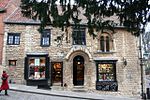St Michael-on-the-Mount
Buildings and structures demolished in the 19th centuryChurches completed in the 1000sChurches completed in the 1850sChurches in Lincoln, EnglandFormer churches in England ... and 1 more
Use British English from August 2024

St Michael-on-the-Mount is a Grade II listed former parish church in the city of Lincoln in the ceremonial county of Lincolnshire, England. The church was originally built in 1000 AD and became later a part of the former Christ Hospital near to the Cathedral and Castle on Steeple Hill.The church was declared redundant in 1998 and was deconsecrated that same year, bringing to an end nearly 1000 years as a place of worship. Today, the church is in use as a hotel called "The Old Palace Lodge Lincoln".
Excerpt from the Wikipedia article St Michael-on-the-Mount (License: CC BY-SA 3.0, Authors, Images).St Michael-on-the-Mount
Christ's Hospital Terrace, Lincoln New Boultham
Geographical coordinates (GPS) Address Nearby Places Show on map
Geographical coordinates (GPS)
| Latitude | Longitude |
|---|---|
| N 53.23332 ° | E -0.53785 ° |
Address
Christ's Hospital Terrace
LN2 1LY Lincoln, New Boultham
England, United Kingdom
Open on Google Maps











